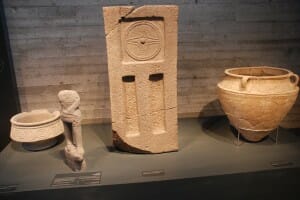
If you are interested in Ancient Israel archaeological treasures, the Samuel and Saidye Bronfman Archaeology Wing at the Israel Museum is a must see. This part of the museum is arranged in 7 chronological chapters that range from the Stone Age through the Ottoman Period. Each part highlights historical events, cultural achievements, everyday life, and the technological advances in the Ancient Land of Israel.
In retrospect, I wish that I would have taken more notes. Thus, I will share just a few select photos so that you can get a taste of what is on display in this sensational permanent exhibit.
For a moment, I thought that I was in an Ancient Egypt exhibit when we walked into this gallery. Unlike the exhibits in Egypt, this one was well lit, well maintained, and clearly marked.
The following two pictures display items from an ancient Chalcolithic burial cave located outside a village in the Upper Galilee. The narrow cave housed burial containers, ossuaries with human faces, and incense burners. These vessels date back to 6500-5500 years ago.
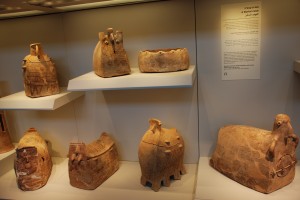
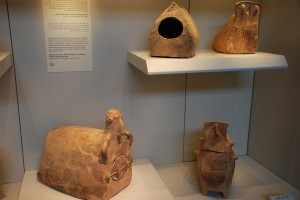
According to the sign, this model home is a rare find. It illustrates the basic layout of an Arad home (3000-2650 BCE). The structure was one story with a flat roof that included gutters that collected rain. There were two rooms- a main room and a room for cooking. The courtyard was used to house livestock, and also for household tasks such as weaving, spinning, and toolmaking.
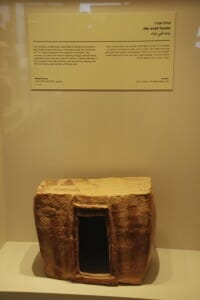
These statues are made of bronze, gold, and steatite. (15th-13th century BCE)
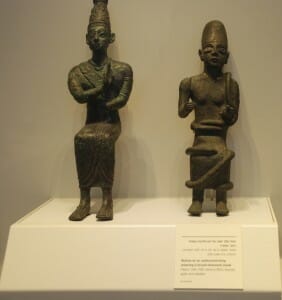
Lions are a frequent Jewish motif. Unfortunately, my camera did not capture any specifics about this sculpture.
The following two silver amulets include the oldest copies of biblical text that have been found to date. They predate the the Dead Sea Scrolls by approximately 500 years.
The amulets were discovered in a burial cave in Jerusalem. The lower part of the Ancient Hebrew inscription is the Priestly Benediction. (Numbers 6:24–26) “The Lord bless and protect you. The Lord deal kindly and graciously with you. The Lord bestow his favor upon you and grant you peace.”
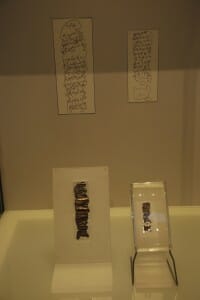
Even though I am unable to identify the next picture, I couldn’t resist including this wonderful piece of ancient craftsmanship.
Likewise, this box remains unidentified.
The display below is a reconstruction of the Susiya Synagogue (southern Hebron hills). The sanctuary had a bima (podium) that was built next to a wall, which had three arched niches. The middle one was for the Torah while the two others had a menorah. There were numerous donor inscriptions on the walls. This suggests the community’s participation in the building’s construction.
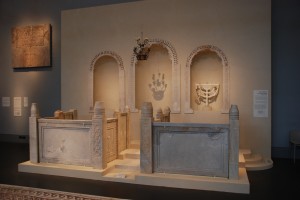
During our visits to Israel, we have had the pleasure to see many intricate mosaic floors at a number of different archaeological sites. I did find a couple of reconstructed mosaics worth sharing. The first was located on the floor near the Susiya synagogue reconstruction.
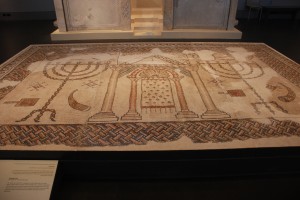
The second picture shows a small sliver of a large mosaic.
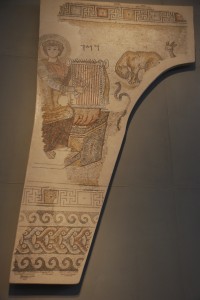
I welcome any archaeological or museum mavens who are willing to shed more light on any of the pictures. Please feel free to comment and share your expertise. The archaeological treasures inside the Israel Museum should be enjoyed by anyone interested in Jewish antiquity.
Sandra Bornstein is the author of MAY THIS BE THE BEST YEAR OF YOUR LIFE. It is available on Amazon.
If you enjoyed reading my memoir, consider posting a review on Amazon, Goodreads, LibraryThing and/or AskDavid.com.
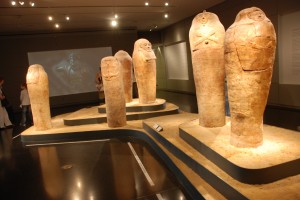
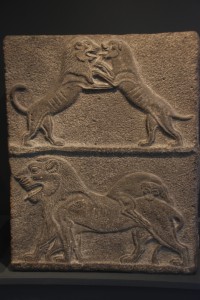
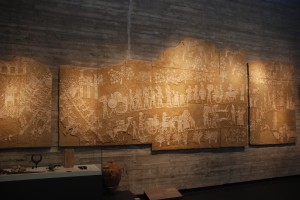
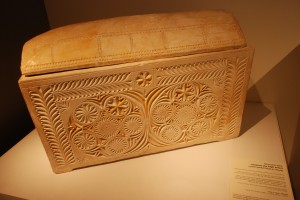
Leave a Reply
You must be logged in to post a comment.